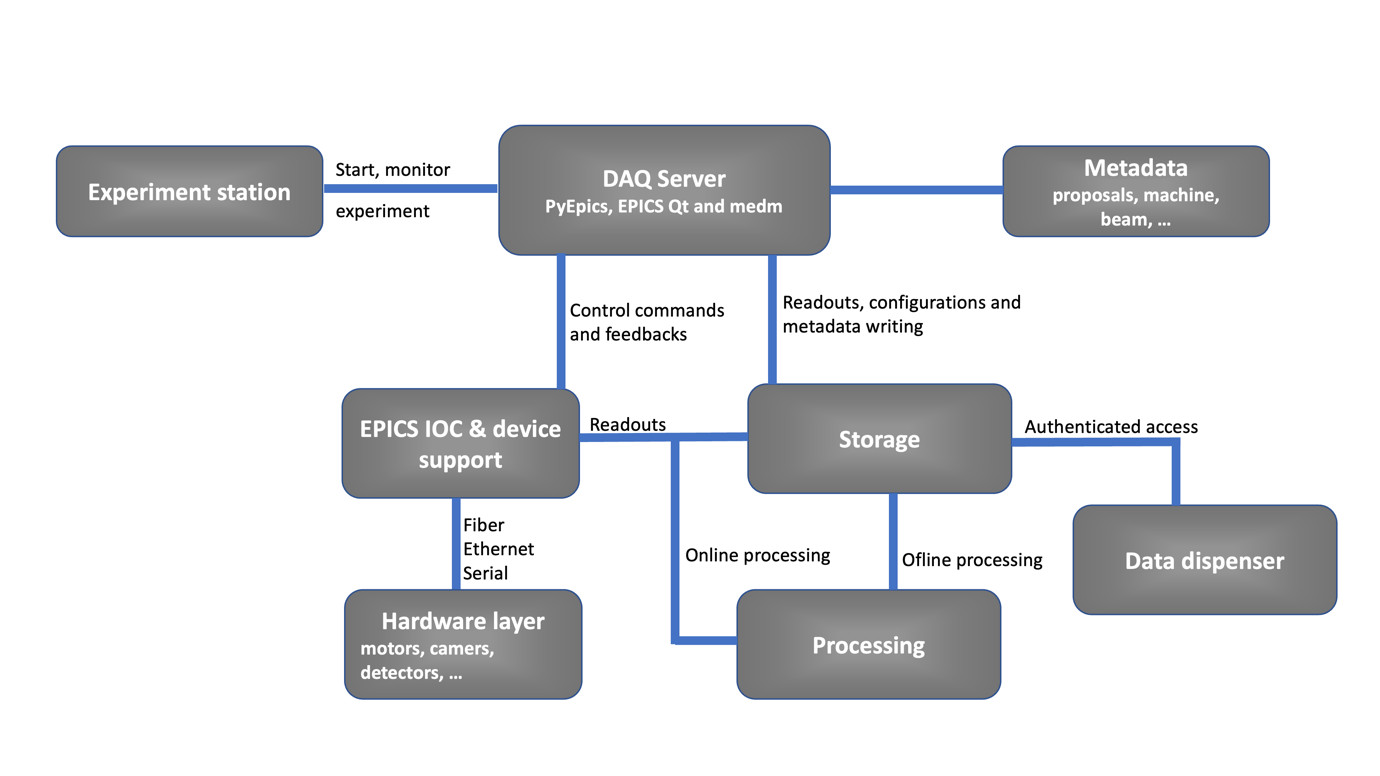Smooth and reliable collection of experimental data has a big impact on the overall success of the experiments being conducted at synchrotron facilities. At SESAME, Data Collection and Analysis team is mainly responsible for ensuring that the experimental data is not randomly generated by acquiring the experimental data and its metadata from the beamlines and other sources, store them together in a stander and well-defined file formats in compliance with SESAME Experimental Data Management Policy.
The team is also responsible for providing the essential pre-processing and post-processing tools that are needed to make the data ready for users and scientists to start their own analysis.
Each beamline at SESAME puts non-identical requirements on data acquisition and processing techniques. The requirements rely also on infrastructure recourses including, but not limited to storage volumes, networking and computing power. The diagram below shows a general layout of the systems and instruments that are needed for obtaining experimental data at SESAME.

Below is a brief description of each system:
- Experiment station:
Each beamline has a Linux / Windows station equipped with all needed software apps to access Data Acquisition (DAQ) Server to start and then monitor the experiment (scanning). - DAQ Server:
It is a beamline dependent server that hosts the DAQ software. Normally, DAQ software is an EPICS client that uses Channel Access (CA) protocol which is an application layer built on top of Transmission Control Protocol and Internet Protocol (TCP/IP) that allows devices to communicate at high speeds on the same network.The DAQ server is interacting with EPICS IOC server(s) by sending commands and receiving feedbacks (i.e., commands to collect data from detector and feedbacks indicating sample position). Also, the server provides Graphical User Interface (GUI) or Command Line Interface (CLI) to let users conducting and monitoring their experiments. Proposal, beam and other related metadata is being collected in this server and then stored in a structured and predefined format in compliance with the Experimental Data Management Policy in the experimental data files.
- EPICS IOC & device support:
It is a beamline and device dependent server that runs EPICS IOC. Drivers for detectors, motion and other devices are installed and configured on such server(s). For more details, please go to control and PSS page. - Hardware layer:
Each beamline has its own hardware instrument; you can visit your desire beamline page for more details. - Storage:
Through DAQ system, all experimental data is being recorded in a beamline-independent storage (centralized storage) at SESAME’s data center with appropriate access permissions. For more details about the storage, please read the Scientific Computing and Systems Communications page. - Processing:
It is a beamline dependent need that depends on a set of computing recourses dedicated for online/offline data processing. The recourses are CPU nodes, power full workstation and a hybrid CPU/GPU cluster. For more details, please go to Scientific Computing and Systems Communications page. - Data dispenser:
It is a beamline independent computer used to let users collecting their own data from the main storage.
Mustafa AL ZUBI
Supervisor Computing Engineer
Email: Mostafa.Zoubi@sesame.org.jo
Work Tel: +962 5 351 1348 (Ext. 333)
Anas MOHAMMAD
Experimental Data Engineer
Email: Anas.mohammad@sesame.org.jo
Work Tel: +962 5 351 1348 (Ext. 334)

